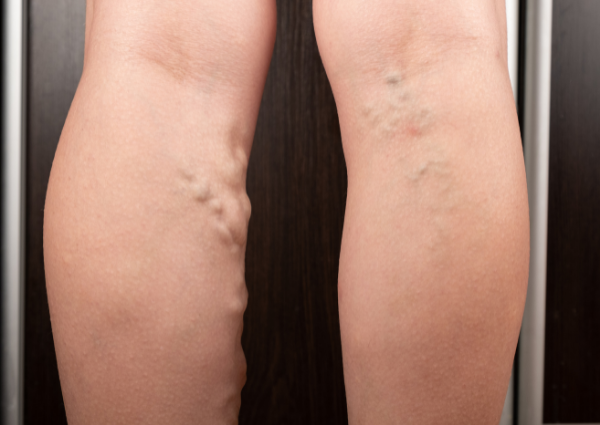How To Treat Deep Vein Thrombosis? Here’s A Definitive Guide

If you’re experiencing any pain, swelling, redness, or discoloration in your legs, you may be prone to blood clots, a condition associated with a vein disease called Deep Vein Thrombosis.
Deep vein thrombosis (DVT) happens when blood clots form in deep veins. If you are not moving for a prolonged period (e.g., when you’re on bed rest or sitting for a long duration), clots in the blood might form, and you may experience pain and swelling.
This condition commonly occurs in the legs, thighs, and pelvis. People with a poor diet, an inactive lifestyle, a history of blood clots, and other health issues may be at high risk.
DVT requires immediate medical attention. Clots that form in the legs can travel through your bloodstream, block blood flow, and even become pulmonary embolisms.
Don’t worry, DVT is treatable and complications are preventable. Keep reading to learn more about this disease and how to cure it.
Causes of Blood Clot
Many factors can restrict blood flow and increase the chance of developing a blood clot. These include:
- Old age
- Family or personal history of blood clotting disorders, DVT, or pulmonary embolism
- Cancer
- A leg vein disease, such as varicose veins
- Smoking
- Hormone therapy or birth control pills
- Pregnancy
- Being overweight or obese
- Recent major surgery
- Having a Central Venous Catheter (CVC)
Signs of Deep Vein Thrombosis (DVT)

If you see these common symptoms and signs of deep vein thrombosis, consult your doctor immediately:
- Cramping pain, tenderness, and swelling of one or both legs
- Warm skin around the affected area, including the legs and other areas
- Skin redness or discoloration of the affected leg area
[Read more about the risks of aching legs]
Complications
One-third to one-half of DVT victims experience chronic venous insufficiency, also known as post-thrombotic syndrome (PTS).
PTS is a potentially life-threatening medical condition that occurs when the blood clot travels through your circulatory system. When clots travel through your vein, it damages the vein valves. Clots can also reach your lungs and trigger pulmonary embolism.
If you notice these symptoms or signs of PTS, call 911 or go to an emergency department for immediate medical attention.
- Sudden breathlessness
- Deep breaths or coughs
- Chest pain.
- Rapid or irregular heartbeat and pulse
- Sudden, bloody cough
- Tight, tight, or sharp chest
- Painful arm, back, jaw, or shoulder
- Dizziness, lightheadedness, or fainting
[To know more about the symptoms, complications, and other risk factors of developing blood clots and DVT, read: 5 Signs of Deep Vein Thrombosis]
How To Treat Deep Vein Thrombosis
Despite the dangers of DVT, there is still hope with the help of proper medications, outpatient treatments, and surgical procedures available. Keep reading for the treatment guide.
DVT Diagnosis
If your doctor suspects DVT, he or she will order diagnostic tests such as:
- Ultrasound to take a picture of your veins, arteries, and blood flow.
- Venography wherein a dye or contrast solution is injected into a vein. The solution is mixed with blood and flows through the veins. An X-ray of the area in which DVT may be suspected is taken to determine any blockages in the veins. This procedure requires radiation, so it is not commonly used unless the ultrasound results are not conclusive.
- D-dimer blood test to detect the presence of D-dimer, a substance released when a blood clot breaks apart. High levels of this substance mean you are at risk for DVT and clotting.
- Magnetic Resonance Imaging (MRI) for detailed cross-sectional images that show the structure of the body, including blood vessels and veins. Doctors may use MRI to locate blood clots within the pelvis and thigh area.
[Related: When To Get Treatment For Blocked Arteries In Legs?]
DVT Treatment
Your doctor will recommend that you undergo these treatments after you have been diagnosed with DVT:
Anticoagulant (blood thinners)
Anticoagulation medication, also known as a blood thinner, may be used to treat DVT. These thinners help prevent future blood clots and help dissolve existing ones.
Blood-thinning medications can cause bleeding problems if the dosage is too high. Use them with caution, at home or in the hospital.
Your doctor may ask for regular blood tests to determine the time it takes for your blood to clot. The dosage of anticoagulants should be sufficient to prevent blood clots, but not excessively.
Compression stockings

Your doctor may advise you to wear compression stockings if you are at high risk of DVT, which can reduce swelling and decrease your chances of developing more clots.
Compression stockings offer tight compression that starts at the lower leg and gradually loosens as it covers the knee. The upward pressure reduces swelling and discomfort in the legs.
If taking blood thinners and wearing stockings don’t work to stop blood clots, or if the clotting worsens, the doctor may recommend outpatient procedures.
Inferior Vena Cava (IVC) Filter Placement
If you are unable to take blood thinners, you might need a filter placed inside your large abdominal vein known as the inferior vena cava (IVC), the large vein that supplies blood to the heart.
The procedure involves inserting a metal device into the IVC. Any clots that become dislodged from the IVC will be caught and prevented from reaching the heart or lungs. This treatment prevents pulmonary embolism.
The use of filters is limited to a short time until the risk is reduced, and blood thinners become available.
Thrombolytic medications
Your doctor may prescribe a thrombolytic drug, such as Anistreplase to treat DVT if blood thinners fail or you have severe symptoms. This medication may be beneficial for people with DVT in the upper extremities.
Thrombolytic medications work by breaking down clots. These medications dissolve blood clots by injecting them through a catheter into the blood. They are only used when there is a high risk of pulmonary embolism.
DVT surgery
Surgical treatment for DVT is done for patients with severe cases. This procedure is usually only recommended for large blood clots or those that cause serious problems like tissue damage.
The goal is to locate and remove the blood clot, then repair the affected blood vessel. The surgeon may use an inflatable balloon to keep the veins open while they remove the blockage. The balloon will then be removed from the area where the clot was found.
Surgery comes with risks, including infection and excessive bleeding. Many doctors would not recommend or perform surgery unless the situation is dangerous for the patient.
Are Blood Clots and DVT preventable?
Just like other medical concerns, you can still prevent DVT by doing the following:
- Maintain a healthy weight and practice a good lifestyle – have a balanced diet and exercise regularly
- Avoid smoking
- Drink alcohol moderately
- Always stay hydrated to maintain a good blood flow
- Move around carefully after your bed confinement due to surgery, sickness, or injury.
- If you recently went under surgery, make sure to follow your doctor’s post-surgery advice
- For patients with a family history of DVT, PE, and blood clotting, discuss your health condition with your healthcare provider to monitor any symptoms.
- Avoid sitting for long periods. If you’re stuck in a seat, stretch your legs, flex your feet, and curl your toes down from time to time.
[Read our complete guide on how to prevent DVT]
Noninvasive DVT Treatments From Expert Vein Specialists
Think you’re at risk of blood clotting or DVT? Don’t ignore the signs – even if they are still mild or moderate!
DVT is a serious condition. Worst case scenario could be fatal. However, taking appropriate measures can help you prevent or recover from it.
Vascular and Interventional Specialists of Prescott (VISP) offers noninvasive and nonsurgical DVT treatments. We also have safe and top-level care treatment for various vascular problems with quick recovery time!
Visit our website to know more about our services, or call us at 928.771.8477 to book an appointment today.
Vascular & Interventional Specialists of Prescott was formed in 2010 by a group of subspecialty radiologists that perform numerous minimally-invasive, low-risk procedures using the tools of our trade for guidance—x-ray, ultrasound, CT scan, and MRI. The team’s goal is to educate patients and medical communities, while also providing safe and compassionate health care, with rapid recovery times and low risk of complications.
